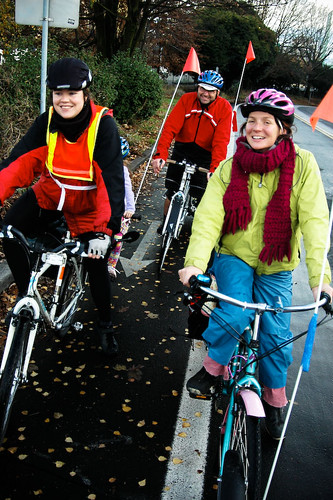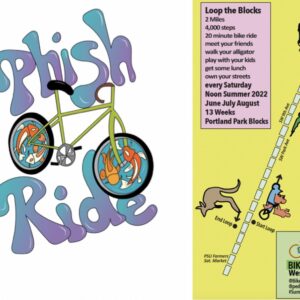This post was written by Kevin Schmidt (MSPT, CMP, Bike PT), licensed Physical Therapist, bike fit specialist, and owner of Pedal PT on SE Clinton.
With the sunny spring weather thousands of new riders are taking to Portland streets. Although pedaling a bike can be a wonderful, empowering, and rewarding experience, more than 80 percent of riders* experience some form of cycling-related pain, numbness, and/or injury- even with short-distance commutes. The good news is a lot of these symptoms are preventable by looking at basic bike fit and pedaling techniques.
Here are some quick tips to help keep you riding more, and hurting less when getting back in the saddle for the first time of the year.
Pedal contact
Regardless of what type of cycling or bike that you ride, always aim to push with the ball of your foot, and centered on the pedal. Using this part of your foot provides the best mechanical advantage for pedaling. Riding self-check: If you find you’re pedaling with the ‘tippy-toes’, it often suggests that your saddle may too high, and that you’re “reaching” at the bottom of the pedal stroke. This can lead to lower back, knee, and/or ankle/calf complaints. Simply lower your saddle in 5mm increments until the ball of your foot naturally finds the center of the pedal.
Knee angle
Believe it or not, but your knees should NOT be completely straight at the bottom of the pedal stroke- a classic new rider misconception, and a great way to develop injury. For optimal comfort, endurance, and injury prevention, aim to have your knee bent roughly 30-35 degrees at the bottom of the pedal stroke, with your heel up slightly (10-20 degrees). A straighter knee can place more stress on the back of the knee and hamstrings, depending on flexibility. Never pedal “heel down” for a prolonged period of time, as this can lead to higher Achilles strain.
Advertisement
Saddle
Generally speaking, the primary goal is to begin with a saddle that is level, as commonly riders will have it tilted a bit ‘nose down’, which dumps more weight on the wrists and hands, leading to numbness/tingling, increased upper arm/neck fatigue, and can also be a factor in knee pain. Self check: With your bike supported (on a trainer or with a partner steadying your bike), sit up on your saddle, hands off of the bars, and just let your body relax and go limp. If you feel you’re sliding forwards, tilt the nose little by little up until you feel level, and that you aren’t going to slide off.
Handlebars and reach
Ultimately, you never want your shoulders reaching farther than 90 degrees (i.e. a right angle from your trunk to shoulders) when you’re flexed over the bike. More upright riders usually don’t have to worry about this, but it’s especially important with road bikes, as anything greater than a 90 degree shoulder angle can lead to neck and mid-back stress, and can also place more pressure on shoulders and hands. Self Check: When starting out, a general rule is to start with your bars equal to (if not higher) that saddle height to bring you more upright to begin. And don’t neglect your posture: aim to keep the lower back flat, with chest elevated to help keep shoulders closer to 90 degrees, and get your head balancing over the shoulders a bit more.
*The statistic comes from a survey of people who did a charity/recreational ride.
— Have bike fit questions? Schmidt is giving a free talk on the topic this Wednesday (4/13).







So, how do you find a saddle? Buy one and hope it’s in good enough shape to return it? Buy one online that sounds like a good idea?
No.
Go to Gladys Bikes up on Alberta (and about 28th). Pay $25 to use their Saddle Library. Try out seats until you find one you like. Try some more. Then try your favorite again and make sure. Then buy that saddle from Gladys and get a $25 discount on your purchase.
In other words, the $25 saddle library costs $0 if you buy a saddle. They have dozens of saddles for all genders.
I second the recommendation for Gladys Bikes Saddle LIbrary. It is well worth the time to check out a saddle and try it out on your bike for a few days. I did the more rapid-fire Saddle Therapy where I tried a series of saddles in a row in the store and bought one after having tried it for a couple of minutes. Great saddle, but I couldn’t get used to it. The good people at Gladys were kind enough to let me exchange it. The second saddle I bought is perfect – I tried it out by riding around the block a couple of times. Braking, cornering and accelerating really helped me make sure it was the right saddle for me. The opportunity to try before you buy is priceless.
Great info Ted! Yes, Gladys Bikes, and a few other shops recently have been offering the genius concepts of the ‘saddle library’ for riders. Always remember that even with the ‘perfect’ saddle shape for your body, it can *still* cause symptoms if positioned improperly (saddle height, tilt, fore/aft, etc..). It can be tricky!
No question- the saddle is a great place to start, and adjusting by hand is good for new/returning to biking, but a fitting (and return fittings) may be necessary. I did just fine before a fitting, then about a thousand miles later I started having a problem that sent me back to fix a pain problem.
Tip: you can save yourself the $25 at Gladys and go to many other shops and test ride saddles for free. I know Western Bike Works, West End Bikes, and the PSU Bike Hub all have these programs. Many other shops probably do as well.
..but it doesn’t cost $25.
Can you try seats for a week at a time?
It does cost $25 if you decide you don’t like what is available at Gladys as far as price, selection, and service. At Western, yes, you can test saddles for a week, for free, no problem.
the $25 goes to what you deem to be the perfect saddle! i’m sure the other shops have expertise, but leah and natalie @ sweetpea bikes are great advisors for ‘serious’ cyclsist and noobs alike. and what a fabulous excuse to get to visit gladys.
this statement is not supported and comes across as a discouraging sentiment:
Here’s the research: http://www.ncbi.nlm.nih.gov/pubmed/7649713
Despite my relative youth, I have poor joints. What would you recommend for making sure I don’t trash my knees cycling? (I have an upright bike so that’s what I’m most worried about, especially when going uphill)
high cadence.
Stay away from Rondos and only descend.
Hey J.E.- Tough to answer specifically without assessment of bike fit, positioning, history, etc, but I’d advise increasing your pedaling cadence (speed of pedaling) as able, as the faster you pedal the less peak torque through the knees (among the other joints) when pedaling. Use your gears as appropriate, and be sure to shift into your easier gears when coming to a stop sign or stoplight- hope that helps!
I have some bad knees as well for my age (had some injuries/surgery when I was younger). Like what’s said by others, a faster cadence can definitely help (not too crazy, you shouldn’t be bouncing in the saddle). But the biggest thing for me was saddle fore/aft positioning. This can take a few rides to dial in, but a typical rule to follow is that if you’re feeling a lot of pressure at the front of your knees, move the saddle back, and if there’s more pressure behind your knees, move the saddle forward. Only move a small amount at a time (you’d be surprised how much of a difference small adjustments can make), and always keep an eye on the maximum adjustment markings on the saddle rails to make sure you stay within the limits to prevent damage.
Don’t be surprised if you have to play around with the saddle height while doing this as well, to get the most comfortable position.
Also, get a set of full-coverage fenders. This is the #1 tip I offer to new riders or riders new to Portland. Not only will you keep yourself and bike drier, you won’t be spraying people behind you either!
Throw some long mudflaps on those full coverage fenders to keep folks behind you dry, I’ve never seen stock fenders that don’t rooster tail.
Biggest protective effect fenders have for your bike are lower headset race and front derailleur. Also, cables that run under your down tube/BB will thank you.
When you say “a right angle from your trunk to shoulders”, does that mean that the angle between the lines drawn along your humerus and thoracic spine should be less than 90 degrees when viewed from the side? I think of my shoulder as a point, rather than a line.
Yep, humerus to thoracic midline, apologies for unclear description. Another way: In standing, raise your arms to 90deg ( i.e. arms parallel to the ground)- You should aim to have this ~90deg angle when hands on hoods (road bike), slight bend in elbows, and while back keeping flat..
Awesome. Thanks!
For true comfort, get thee to a recumbent shoppe.
Another idea is to find a frame with a really long wheelbase. I rode a vintage mtb all over Europe, one with a ridiculous wheelbase, and I was very comfortable. I didn’t get very fast, using more quads than hamstrings (long debate about this as you might imagine) but it was super cozy. Plus unlike a recumbent I could get it on buses and my head wasn’t at bumper / tailpipe level… but to each their own…